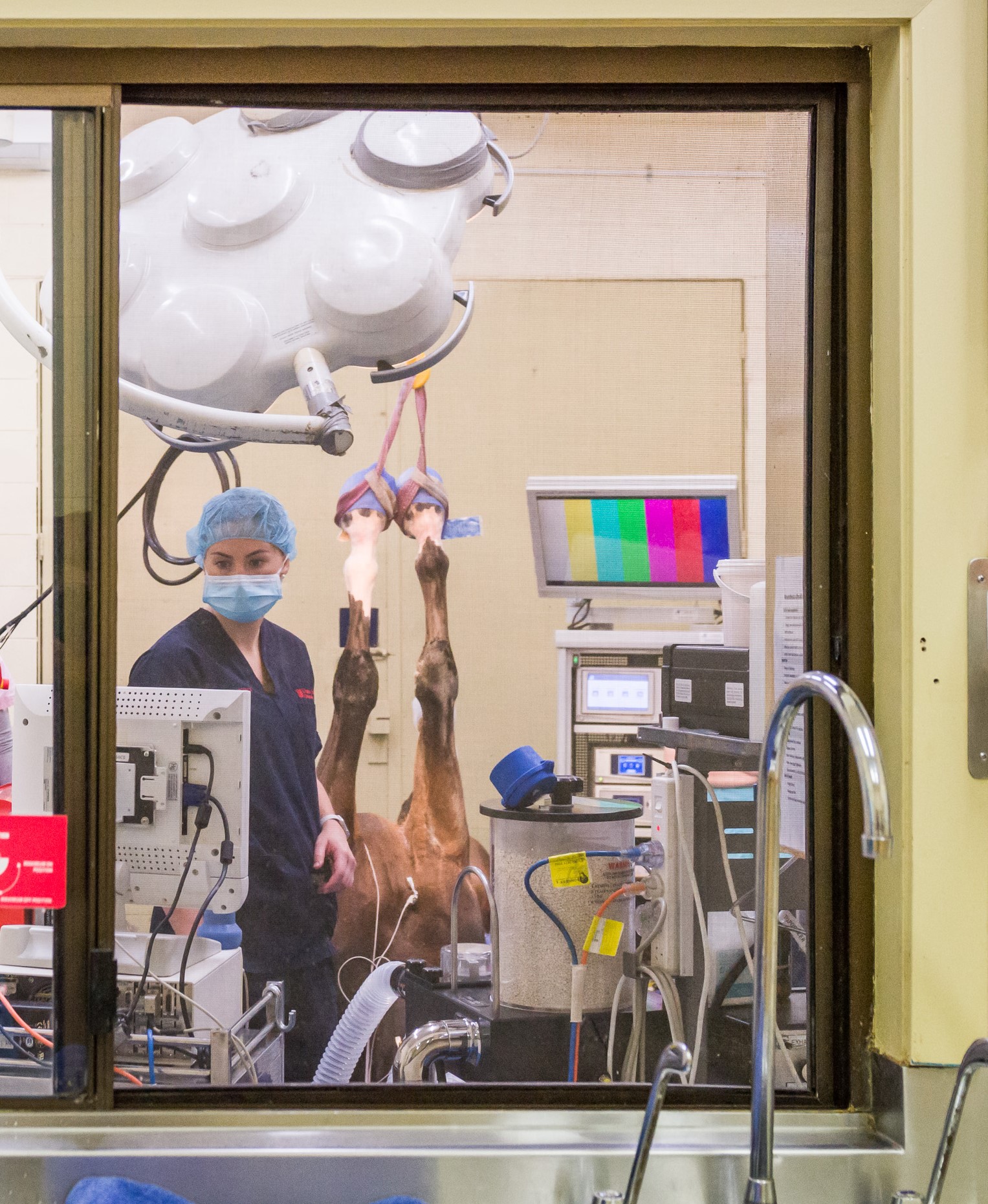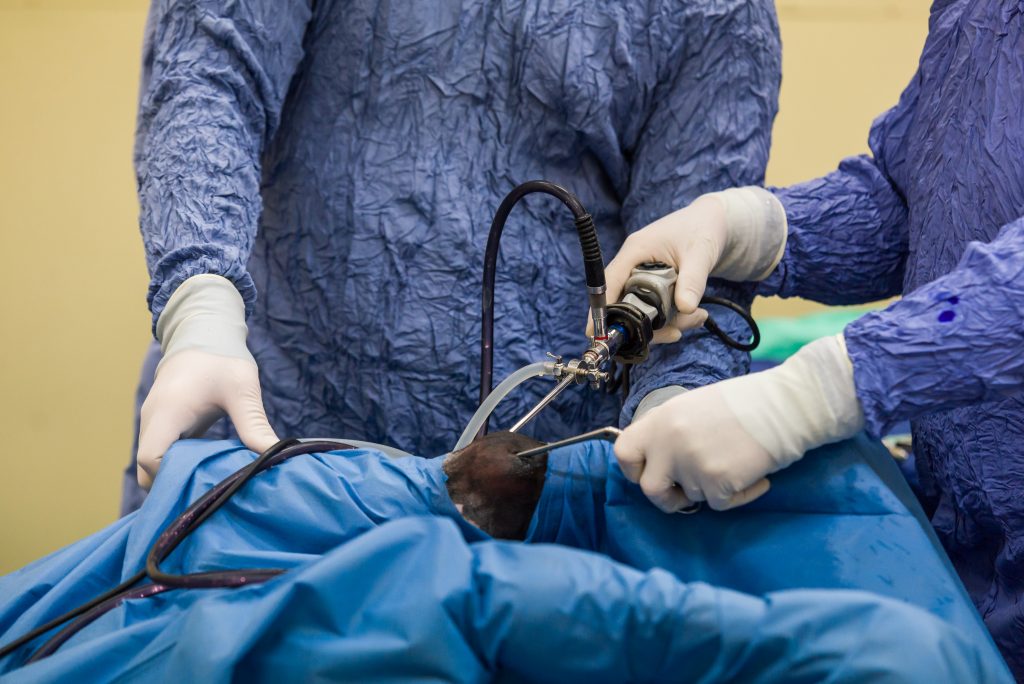Surgery
At Goulburn Valley Equine Hospital we have two fully equipped surgical suites that are designed to optimise the care of your horse during surgery.
We have three padded induction / recovery rooms which lead into our surgical suites.
On admission to the hospital for surgery, your horse will undergo pre-operative assessment which will vary depending on the surgery required. This may include x-rays, endoscopic examination of the airway, ultrasound or further lameness assessment.
Following communication with the owners / trainer / insurance company/ referring veterinarian, the horse is prepared for surgery. This includes a thorough clinical examination, weighing and pre-operative medications.

The sedated horse is then anaesthetised in one of the padded induction rooms, and then rolled into the adjacent air-conditioned suite. Patients are then intubated and placed on a ventilator. GVEH has a team of dedicated and trained veterinarians who monitor all the anaesthetics with the assistance of state of the art anaesthetic monitoring equipment.
At GVEH we offer a full range of surgical procedures. As well as general surgical procedures, we specialise in more complex procedures such as various airway surgeries, orthopaedic surgeries, laparoscopy, cryosurgery , laser surgeries, sinus surgeries, reproductive surgeries, eye surgeries, colic surgeries as well as many foaling complications including dystocia’s.
Orthopaedic surgery
The surgeons at GVEH are trained and experienced in managing a wide variety of orthopaedic conditions, from arthroscopies, sequestrum removals, to advanced fracture management. We will discuss all options with you before committing to surgical management of your horse’s orthopaedic condition.
Not all fractures to a horse’s skeletal system mean they need to be euthanised. Some fractures (depending on the severity) can have screws and/or plates implanted to help stabilize the bone and allow the horse to continue to be mobile. Depending on the type of fracture, some horses may even be able to become a competitive horse again.

Airway surgery
A horse’s oxygen demands during exercise are very high so upper airway disease may impair their ability to perform.
After using various diagnostic tools including endoscopy (resting or dynamic), ultrasound and radiography we can identify the problem within the airway and with different surgical procedures our team can help your horse back to its peak performance.
Common issues we identify in horses with loss of performance include:
- Roarers (left laryngeal hemiplegia)
- Dorsal displacement of the soft palate
- Entrapped epiglottis
- Chondritis
In the last five years alone we have performed over 300 tie back surgeries (surgical management of roarers) and have a high success rate in getting horses back to their intended discipline.
Sequestrum removal
Unfortunately some lacerations and wounds can damage horse’s bone; once the bone has been traumatised it then can form a sequestrum.
A sequestrum is a piece of dead bone that can take a few weeks to form. As it may not be identified immediately, the wound may look as it is progressing well, but the sequestrum will make the wound not heal entirely. Removal of a sequestrum can vary from simple to become quite a complex surgery.
Depending on the location and the severity of the sequestrum your horse may need to have a general anaesthetic, this will allow our team the best chance to remove all affected bone.
Mass/Sarcoid removal
Some horses like humans, may form masses from unknown origins.
Samples of the mass can be sent away for histopathology for further identification. We may use combinations of surgical removal, chemotherapy, laser resection or cryotherapy to treat the mass or sarcoid.
Sinus surgery
A sinus is an air filled cavity within the horses head; horses have six pairs of paranasal sinuses.
Infection of the sinus/sinuses can be challenging to treat and it is important to identify if there is an underlying cause (eg. Dental disease, trauma etc).
Sinus surgery initially can be performed standing using a trephine. This puts a small hole into the sinus allowing access with an endoscope or flushing catheter. Access to the sinus can be improved further with a bone flap which can be performed standing or under general anaesthetic.
Angular/Flexural Limb Deformity
Not all foals are born with straight legs and deviations can be remedied with surgery.
Our surgeons will assess your foal’s limbs and then make a plan as to what is the best type of procedure to correct the deviation. This procedure is time sensitive, and must be performed while the foal is quite young. We recommend assessing deformities at 3 weeks old (or sooner if the deviation is severe).
Bone marrow transfer (BMT)
Once an injury has been confirmed in a tendon or ligament, treatments can include procedures like a bone marrow transfer.
This procedure is where bone marrow is aspirated from the horse’s sternum, and then injected under ultrasound guidance into the core lesion.
Bone marrow is the soft, sponge-like material found inside bones. Injection of bone marrow into a lesion can help with the healing rates and may assist your horse to get back to intended use faster.
Intravenous Regional Perfusion (IVRP)
Sometimes infection in the lower limb of a horse can be quite difficult to treat.
Depending on what underlying structures are involved with the injury IVRP may be used to force a high concentration of antibiotics into the distal limb. Whilst this is a reasonably easy procedure and can be performed standing sometimes, anaesthesia may be required (consideration to disposition of the horse, injection site and location of the required tourniquet).
Once the tourniquet has been placed a small amount of antibiotic and sterile saline is injected into the area, the tourniquet is left in place for around 20 minutes. This procedure can be repeated if needed in the following days.
Anaesthetic systems
Our two Mallard Anesthesia Systems allow our practitioners to monitor horses during the complex anesthesia process, predicting and preventing potential anesthetic problems.
The machines use mixed gas to ensure accurate concentrations and allow the anesthetist to fine tune the inhalant agent for the best possible anesthetic depth. This equipment enables our staff to monitor:
- Constant heart rate
- Electrocardiogram (ECG)
- Blood pressure
- Oxygenation status
Arterial blood gases are routinely performed throughout extended surgical procedures. Each anesthetic machine allows continuous ventilation of the horse on the adult or foal circuit, allowing us to perform two surgeries concurrently and avoid delays in emergencies.
The machines also enable continuous monitoring during recovery in our heavily padded recovery boxes, which are equipped with a direct oxygen supply and video monitoring to support a safe and efficient recovery.
